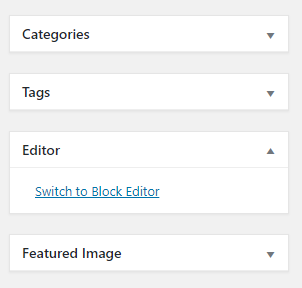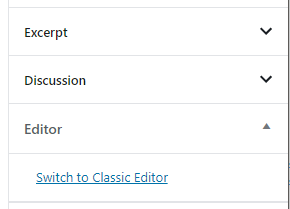Aprašymas
Klasikinis redaktorius yra oficialus įskiepis, kurį palaiko WordPress komanda, šis įskiepis sugrąžina senajį įrašo redagavimo ekrano vaizdą bei galimybę naudoti kitus įskiepius, kurie priklauso nuo senojo redaktoriaus.
Klasikinis redaktorius yra oficialus WordPress įskiepis ir bus pilnai palaikomas bent iki 2022-ųjų, arba tiek, kiek reikės.
Įskiepis suteikia tokias galimybes:
- Administratoriai gali nustatyti numatytąjį redaktorių visiems vartotojams.
- Administratoriai gali leisti vartotojams pasirinkti norimą redaktorių.
- Kai įjungtas toks leidimas, vartotojai gali pasirinkti, kurį redaktorių nori naudoti kiekvienam atskiram įrašui.
- Kiekvienas įrašas redaguojant atsidaro su tuo redaktoriumi, kuris pastarajį kartą buvo jam naudotas, nepriklausomai, kuris vartotojas tai darė. Tai padeda išlaikyti vientisą turinio redagavimo aplinką.
Be paminėtų galimybių, Klasikinis redaktorius turi kelis filtrus kurie leidžia kitiems įskiepiams naudoti jo nustatymus, redaktoriaus pasirinkimą įrašui ar įrašo tipui.
Šis įskiepis taip pat paslepia visas naujojo Blokų redaktoriaus (Gutenberg“) funkcijas.
Ekrano nuotraukos

Nustatymai Administratoriui Skydelio skiltyje Nustatymai -> Rašymas. 
Vartotojo nustatymai jo profilyje. Matomi tik tada, kai vartotojams leidžiama pasirinkti norimą redaktorių. 
Nuorodos redaktorių pasirinkimui įrašų / puslapių sąrašuose. Matomos tik tada, kai vartotojams leidžiama pasirinkti norimą redaktorių. 
Nuoroda, kurios pagalba galima pakeisti redaktorių į Blokų, rašant įrašą Klasikiniame redaktoriuje. Matoma tik tada, kai vartotojams leidžiama pasirinkti norimą redaktorių. 
Nuoroda, kurios pagalba galima pakeisti redaktorių į Klasikinį, rašant įrašą Blokų redaktoriuje. Matoma tik tada, kai vartotojams leidžiama pasirinkti norimą redaktorių. 
Tinklo nustatymai numatytajam redaktoriui parinkti bei suteikti galimybę tinklalapių administratoriams jį pakeisti. 
Nuoroda pakeitimui į Klasikinį redaktorių.
DUK
- Numatytieji nustatymai
-
Įjungus, šis įskiepis atstatys senajį (klasikinį) WordPress redaktorių ir paslėps naujajį Blokų redaktorių („Gutenberg“).
Šie nustatymai gali būti pakeisti Skydelio skiltyje Nustatymai => Rašymas. - Numatytieji nustatymai multitinklalapiui
-
Yra du variantai:
- Įjungus Klasikinį redaktorių visame tinkle, jis taps numatytuoju visiems ir nei atskirų tinklalapių administratoriai nei vartotojai negalės pasirinkti kito redaktoriaus.
Nustatyti numatytąjį redaktorių visame tinkle ar jį pakeisti galite Skydelio skiltyje Tinklo nustatymai. - Kai Klasikinis redaktorius nėra įjungtas visam tinklui, kiekvieno tinklo tinklalapio administratorius gali pats įjungti šį įskiepį ir parinkti nustatymus savo vartotojams.
- Įjungus Klasikinį redaktorių visame tinkle, jis taps numatytuoju visiems ir nei atskirų tinklalapių administratoriai nei vartotojai negalės pasirinkti kito redaktoriaus.
- Nerandu nuorodos pakeitimui į Klasikinį redaktorių
-
Nuoroda yra pagrindiniame Blokų redaktoriaus meniu, žiūrėkite ekrano nuotrauką.
Atsiliepimai
Programuotojai ir komandos nariai
“Classic Editor (Klasikinis redaktorius)” yra atviro kodo programa. Prie jos sukūrimo prisidėję žmonės surašyti toliau.
AutoriaiĮskiepis “Classic Editor (Klasikinis redaktorius)” išverstas į 52 kalbas. Dėkojame vertėjams už jų darbą.
Išverskite “Classic Editor (Klasikinis redaktorius)” į savo kalbą.
Interested in development?
Browse the code, check out the SVN repository, or subscribe to the development log by RSS.
Pakeitimų istorija
1.5
- Updated for WordPress 5.2 and Gutenberg 5.3+.
- Enhanced and fixed the „open posts in the last editor used to edit them“ logic.
- Fixed adding post state so it can easily be accessed from other plugins.
1.4
- On network installations removed the restriction for only network activation.
- Added support for network administrators to choose the default network-wide editor.
- Fixed the settings link in the warning on network About screen.
- Properly added the „Switch to Classic Editor“ menu item to the Block Editor menu.
1.3
- Fixed removal of the „Try Gutenberg“ dashboard widget.
- Fixed condition for displaying of the after upgrade notice on the „What’s New“ screen. Shown when the Classic Editor is selected and users cannot switch editors.
1.2
- Fixed switching editors from the Add New (post) screen before a draft post is saved.
- Fixed typo that was appending the edit URL to the
classic-editorquery var. - Changed detecting of WordPress 5.0 to not use version check. Fixes a bug when testing 5.1-alpha.
- Changed the default value of the option to allow users to switch editors to false.
- Added disabling of the Gutenberg plugin and lowered the required WordPress version to 4.9.
- Added
classic_editor_network_default_settingsfilter.
1.1
Fixed a bug where it may attempt to load the Block Editor for post types that do not support editor when users are allowed to switch editors.
1.0
- Updated for WordPress 5.0.
- Changed all „Gutenberg“ names/references to „Block Editor“.
- Refreshed the settings UI.
- Removed disabling of the Gutenberg plugin. This was added for testing in WordPress 4.9. Users who want to continue following the development of Gutenberg in WordPress 5.0 and beyond will not need another plugin to disable it.
- Added support for per-user settings of default editor.
- Added support for admins to set the default editor for the site.
- Added support for admins to allow users to change their default editor.
- Added support for network admins to prevent site admins from changing the default settings.
- Added support to store the last editor used for each post and open it next time. Enabled when users can choose default editor.
- Added „post editor state“ in the listing of posts on the Posts screen. Shows the editor that will be opened for the post. Enabled when users can choose default editor.
- Added
classic_editor_enabled_editors_for_postandclassic_editor_enabled_editors_for_post_typefilters. Can be used by other plugins to control or override the editor used for a particular post of post type. - Added
classic_editor_plugin_settingsfilter. Can be used by other plugins to override the settings and disable the settings UI.
0.5
- Updated for Gutenberg 4.1 and WordPress 5.0-beta1.
- Removed some functionality that now exists in Gutenberg.
- Fixed redirecting back to the Classic Editor after looking at post revisions.
0.4
- Fixed removing of the „Try Gutenberg“ call-out when the Gutenberg plugin is not activated.
- Fixed to always show the settings and the settings link in the plugins list table.
- Updated the readme text.
0.3
- Updated the option from a checkbox to couple of radio buttons, seems clearer. Thanks to @designsimply for the label text suggestions.
- Some general updates and cleanup.
0.2
- Update for Gutenberg 1.9.
- Remove warning and automatic deactivation when Gutenberg is not active.
0.1
Initial release.